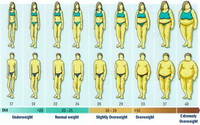|
Body Composition – Using BMI As A True Measurement Of Weight
What do we mean by body composition? This refers to the proportions of muscle, bone, fat and other tissues in the body. This chemical and anatomical composition of the body is actually more important than body weight. Some individuals may step on the scale and based upon their weight only, think that they are too fat or too skinny. Two individuals with the same height and weight on the high side may have very different increased risks for disease, one could have a higher proportion of fat and be at risk for disease and another could have a higher proportion of muscle and be considered fit, yet both of these individuals have the same height and a weight on the high side.
We know that an excessive amount of fat on the body is linked to increased health risks such as hypertension, heart disease, diabetes, cancer, and other chronic diseases. So, how do we actually measure whether someone is truly obese and at risk for disease? This is done through measuring what is known as the BMI or which uses both height and weight to calculate a number that will indicate a truer picture of whether a person is obese, overweight or even underweight, which is also a sign of less than optimum health and can leave an individual open to a host of other chronic diseases. Calculating Body Mass Index (BMI) Where kg is kilograms, m is meters, lb is pounds, in is inches, and sq is squared. The BMI is a ratio of weight to height given as a formula which is BMI = weight (kg)/height (m sq) or BMI = weight (lbs)/height (in sq) x 704.5 According to the National Heart, Lung, and Blood Institute being underweight, normal weight, overweight, and obese is defined as follows:
By calculating your BMI and using a BMI chart to look up your height and weight, you can then see which range your BMI falls into.
For a printable copy of the BMI chart for adults as part of understanding body composition click on the link to nhlbi.nih.gov In summary, using BMI as a measurement of body composition in terms of weight and height helps to demonstrate that having a model thin body may look good to some and be desired by many, but this is not necessarily a healthy body type and can be a measure of being underweight and at risk for its own diseases. Being of a certain higher weight if that weight is muscle may not necessarily indicate an unhealthy body type simply because the weight is higher, but could be indicative of good health, whereas if the higher weight is from fat, then this can be an indication for health risks depending upon whether the BMI indicates that the individual is overweight or obese. Weight by itself is not a good predictor of disease risk, knowing the BMI for your height and weight can help you to make healthy food choices based on knowing your true risk for disease. For other information on nutrition including information about body composition some great references are: • Nutrition – Fourth Edition by Paul Insel, Don Ross, Kimberley McMahon, and Melissa Bernstein
Cooking Recipes
|







